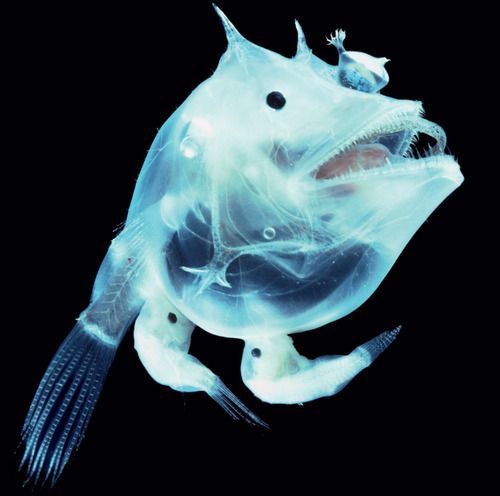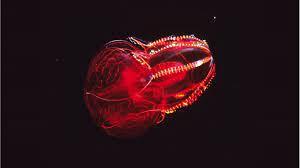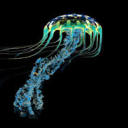Black Dragonfish



Black Dragonfish
Idiacanthus atlanticus
The Black Dragonfish are needle-like fish that migrate between 500m and 2000m in the deep ocean. Females are black with 6 stripes and lack a barbel, pelvic fins, and sharp teeth. Males, on the other hand, are dark brown and have a barbel, which is the light producing structure on its chin. Furthermore, it uses bioluminescence to detect prey instead of lure prey.
Photo credit: https://scitechdaily.com/scientists-learn-secrets-from-ultra-black-skin-that-allows-deep-sea-fish-to-lurk-unseen/
https://steemit.com/life/@munnashah/the-most-terrible-and-surprising-7-animals-of-the-sea
https://knowyourmeme.com/photos/995601-thalassophobia
More Posts from Bioluminescentoceangoddess and Others

Threadfin Snailfish
Careproctus longifilis
The Threadfin Snailfish resembles a prehistoric tadpole that is ghostly white. The holes in its face are large sensory pores that help them detect changes in the ocean. It is often found at depths between 1900 to 2997 meters.
Photo credit: https://www.timeout.com/singapore/museums/creatures-of-the-deep


Deep-sea white anglerfish
Haplophryne mollis
The Deep-sea white anglerfish is a ghostly white creature found at depths between 1000m to 4000m. The strange bulge between its eyes is a bioluminescent lure. The main fish above is a female and the tiny fish attached to her body are males. Since it is difficult to find mates in the deep ocean, male fish latch onto the female with hooked teeth. Even though the male fish are parasitic, they are eventually reduced to pockets of sperm that are used for reproduction. For all you fellas out there that have a rough time with the ladies, be thankful that you are at least not a bag of gonads floating through the ocean.
Photo credit: https://www.pinterest.co.uk/pin/440297301041956897/
https://news.cgtn.com/news/3d3d414d3559444f7a457a6333566d54/share_p.html

Scaly Dragonfish
Stomias Boa
The Scaly Dragonfish is about 32cm long and found at depths between 200 to 1500m. The long purple barbel on its chin is used to lure in prey. When the pery gets close enough, it swings its jaws forward swallowing the prey whole.
Photo credit: https://alchetron.com/Stomias
Video on the fish: https://www.youtube.com/watch?time_continue=69&v=9oB_61aI2iQ&feature=emb_title

Black- eyed squid
Gonatus onyx
The Black-eyed Squid is roughly over one foot (35 am) and is found at depths as deep as 2500m. The female Black-eyed Squid works fiercely to protect her babies, by carrying around a patch of egg for six to nine months. When the eggs hatch, 2000 to 3000 babies are released into the ocean. However, this makes her vulnerable to predators.
Photocredit: http://tolweb.org/Gonatus+onyx/19769


Mid-water Arctic Hydrozoan
Botrynema brucei
The Mid-water Arctic Hydrozoan is a mini-jelly that is transparent with hints of blue. It thrives in freezing cold temperatures and drifts aimlessly in the Artic Ocean. Moreover, it is only 3 cm in size and floats between 900m to 2,600m.
Photo credit: https://en.wikipedia.org/wiki/Botrynema_brucei
http://www.arcodiv.org/watercolumn/cnidarian/Botrynema_brucei.html
An amazing glowing ctenophore!


Bloody-belly comb jelly
Lampocteis cruentiventer
The Bloody-belly is a 16 cm ctenophore that is found at depths 700 m to 1200m. It is crimson red in color and appears black in the deep ocean. However, the jelly has the ability to emit a different color. Furthermore, it uses highly iridescent ctenes to propel through the water.
Photo credit: https://laughingsquid.com/bloody-belly-comb-jelly/
https://www.reddit.com/r/deepseacreatures/comments/2j1717/bloodbelly_comb_jelly_lampocteis_cruentiventer/



Fangtooth
Anoplogaster cornuta
The Fangtooth is a ferocious predator that is found at depths between 600 m to 5000 m. It has large, needle like teeth that are used to catch prey. It also has extremely sensitive sensory canals underneath of its scales used to detect movement in the water. Furthermore, their preferred prey are crustaceans and fish.
Photo credit: https://pixels.com/featured/fangtooth-fish-dant-fenolio.html
https://www.pinterest.com/pin/845902742487789950/
https://www.newscientist.com/article/mg23231020-400-up-close-with-the-giant-teeth-of-the-deepsea-fangtooth/


Silky Medusa
Colobonema sericeum
The Silky Medusa is a gentle and reserved jellyfish; it has white-tipped tentacles that have the ability to detach from its body and bioluminescence when attacked by predators. It can be found drifting between 500 m to 1500 m. Furthermore, it consumes small crustaceans.
Photo credit: https://twitter.com/mbari_news/status/949736123760340994
https://www.montereybayaquarium.org/animals/animals-a-to-z/midwater-jelly
Sea sparkle is a common, bioluminescent plankton. Even though its not an animal, it is worth sharing.


Sea sparkle
Noctiluca scintillans
Sea sparkle is a bioluminescent dinoflagellate that blooms in many coastal waters. Sea sparkle feeds on plankton, diatoms, fish eggs, and other dinoflagellates. It also has a flagellum, or tiny tail, that helps it move around in the water. Even though sea sparkle is beautiful to witness at night, it is hazardous to other marine species and resembles a reddish-pink film during the day.
Photo credit:
https://alexandrathemb.tumblr.com/post/49814932878/noctilucas-scintillans-a-bioluminescent
https://thevelv.blogspot.com/2015/07/noctiluca-scintillans.html

Sea Angel
Cliopsis krohni
The Sea Angel is a tiny snail that is only 4 cm in length and found at depths as deep as 1500 m. Even though it is small, it is a viscous predator. It hunts other midwater snails using a structure called a radula. Unlike other snails, the Sea Angel’s mouth is located on top of its head. It also uses swimming “wings” to propel through the water.
Photo Source: http://seaslugsofhawaii.com/species/Cliopsis-krohni-a.html
-
 amorxsomnia liked this · 11 months ago
amorxsomnia liked this · 11 months ago -
 nightingaleinberkleysquare liked this · 1 year ago
nightingaleinberkleysquare liked this · 1 year ago -
 merpdaberp liked this · 1 year ago
merpdaberp liked this · 1 year ago -
 albinopotoo liked this · 2 years ago
albinopotoo liked this · 2 years ago -
 zindabad liked this · 2 years ago
zindabad liked this · 2 years ago -
 amoebaenvy liked this · 2 years ago
amoebaenvy liked this · 2 years ago -
 memorycare reblogged this · 2 years ago
memorycare reblogged this · 2 years ago -
 radioceann liked this · 2 years ago
radioceann liked this · 2 years ago -
 angrymilkshakepeace liked this · 2 years ago
angrymilkshakepeace liked this · 2 years ago -
 smallaphid liked this · 2 years ago
smallaphid liked this · 2 years ago -
 missthingwiththedemonwing reblogged this · 3 years ago
missthingwiththedemonwing reblogged this · 3 years ago -
 sjukvarld liked this · 3 years ago
sjukvarld liked this · 3 years ago -
 lily-ily-ly liked this · 3 years ago
lily-ily-ly liked this · 3 years ago -
 its-11dani liked this · 3 years ago
its-11dani liked this · 3 years ago -
 aganatis liked this · 3 years ago
aganatis liked this · 3 years ago -
 earthquache liked this · 3 years ago
earthquache liked this · 3 years ago -
 ryzomeriseup liked this · 3 years ago
ryzomeriseup liked this · 3 years ago -
 softichill liked this · 3 years ago
softichill liked this · 3 years ago -
 bluurei liked this · 3 years ago
bluurei liked this · 3 years ago -
 nightmaregorepng liked this · 3 years ago
nightmaregorepng liked this · 3 years ago -
 sewer-dweller liked this · 3 years ago
sewer-dweller liked this · 3 years ago -
 astrotracksuitbattalion liked this · 3 years ago
astrotracksuitbattalion liked this · 3 years ago -
 acolorcollective liked this · 3 years ago
acolorcollective liked this · 3 years ago -
 despair-with-walnuts liked this · 3 years ago
despair-with-walnuts liked this · 3 years ago -
 808beat liked this · 3 years ago
808beat liked this · 3 years ago -
 in-soft-grass liked this · 3 years ago
in-soft-grass liked this · 3 years ago -
 lloop--iolet reblogged this · 3 years ago
lloop--iolet reblogged this · 3 years ago -
 lloop--iolet liked this · 3 years ago
lloop--iolet liked this · 3 years ago -
 in-w0nderland reblogged this · 3 years ago
in-w0nderland reblogged this · 3 years ago -
 in-w0nderland liked this · 3 years ago
in-w0nderland liked this · 3 years ago -
 doze-dingo liked this · 3 years ago
doze-dingo liked this · 3 years ago -
 mixed-matches liked this · 3 years ago
mixed-matches liked this · 3 years ago -
 eidola-eidola liked this · 3 years ago
eidola-eidola liked this · 3 years ago -
 shockwave-the-dog liked this · 3 years ago
shockwave-the-dog liked this · 3 years ago -
 gaycultists liked this · 3 years ago
gaycultists liked this · 3 years ago -
 quervous liked this · 3 years ago
quervous liked this · 3 years ago -
 eatinants reblogged this · 3 years ago
eatinants reblogged this · 3 years ago -
 ophiocordyceps liked this · 3 years ago
ophiocordyceps liked this · 3 years ago -
 mr-crix liked this · 3 years ago
mr-crix liked this · 3 years ago

Bioluminescence is a chemical reaction that produces light. Many deep sea animals use bioluminescence. This blog is dedicated to educating the public about the amazing creatures that thrive in the deep sea.
57 posts